|
|
|
|
|
Intel "Pentium D" and "840 Extreme Edition" Dual-Core CPUs |
|
Join the community - in the OCAU Forums!
|
Multitasking Benchmarks
In our multitasking scenario 1 we are backing up a movie DVD with the popular “DVD Shrink” program to the harddisk. At the same time several common desktop tasks are running in the background. The sequence is as follows:- Launch Mozilla “Firefox” and load locally archived copies of 10 webpages with heavy flash content in tabs while keeping the browser on the OCAU frontpage
- Launch “iTunes” and loop a playlist
- Launch “BitTorrent 4.1” and start downloading 3 files
- Launch “DVD Shrink” and start a backup of a pre-recorded movie DVD to the hard disk
Additionally “MS AntiSpyware” and “MicroTrend Internet Security” were running during this and all other multitasking scenarios in the background at all times. DVD Shrink was kept in the foreground and running with default settings. Windows Task Manager shows that this multitasking scenario utilizes the HT capable 840XE by around 50%.
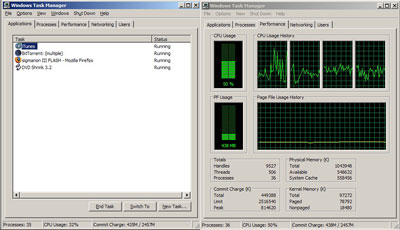
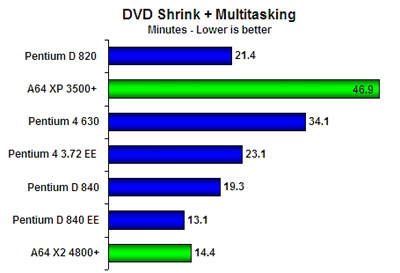
The results demonstrate how superior dual core processors are performing in multitasking. The single cores, with the exception of the 3.73 GHz XE, are left behind. The single core XP 3500+, even more handicapped with its lack of HT capability, is left far behind by the competition. The 2.8 GHz 820 is more than 30% faster than a single core 3.0 GHz 630. The single core 3.73 GHz XE with HT and running with a 1066 MHz system bus remains a strong contender in this multitasking scenario. However, it can’t outrun the 820 - clocked almost 1 GHz lower and 4 times cheaper. The 840XE performs substantially better than the 840, obviously thanks to HT. And although the X2 4800+ was beating the 840XE in almost all single task benchmarks we now see the 840XE taking a small lead.
Multitasking scenario 2 “Web Browsing” was arranged in the following way:- Launch Mozilla “Firefox” and load locally archived copies of 10 webpages with heavy flash content in tabs while keeping the browser on the OCAU frontpage
- Launch “iTunes” and start looping a playlist
- Launch “BitTorrent 4.1” and start downloading 3 files
- Launch “MS Outlook” and start importing a large (around 140 MB) .pst file with e-mail messages, and switch back to Firefox
We recorded the time to import the .pst file into “Outlook” while the webbrowser was kept as foreground task. The advantage of dual core processing is again clearly visible in this scenario. The 2.8 GHz 820 is almost 20% faster than the 3.0 GHz 630, and still faster than the 3.73 GHz XE. Again we can see that the 840XE thanks to HT is faster than the 840 and running neck-to-neck with the X2 4800+.
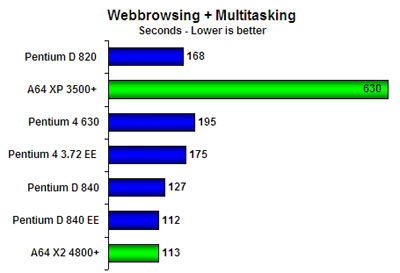
Our third multitasking scenario “3D rendering” was set up as follows:- Launch Mozilla “Firefox” and load locally archived copies of 10 webpages with heavy flash content in tabs while keeping the browser on the OCAU frontpage
- Launch “iTunes” and start looping a playlist
- Launch “BitTorrent 4.1” and start downloading 3 files
- Launch “3ds max 7” and run the “underwater” final rendering task from the single task benchmarks
Professional 3D rendering is an extremely time and CPU cycle-consuming task. 3D rendering in a multitasking environment puts therefore great stress on the CPU. The load in this multitasking scenario was obviously too much for the XP 3500+. The system became unresponsive and we stopped the benchmark. The 3D rendering multitasking scenario shows the most pronounced performance difference between single and dual core products. The 2.8 GHz 820 is a mighty 50% faster than the single core 3.0 GHz 630 and is still outrunning the single core 3.73 GHz XE by 20%. We also see a big impact of Hyper-Threading: the 840XE is a full 30% faster than the 840 running at the same clock speed but without HT. For professional usage, when time is money, using a dual core CPU for 3D rendering is a must. It can save hours of working time. HT puts the 840XE again ahead of the competing 4800+. When running “3ds max 7” as single task, 840XE and X2 4800+ perform identical, but in our multitasking scenario the 840XE is 7% faster.
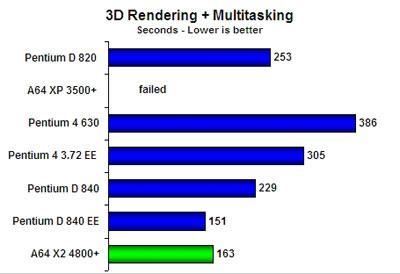
Our last multitasking scenario “gaming” is based on “Doom 3” running with a resolution of 1024 x 768 x 32 and highest image quality. This scenario was arranged as follows:- Launch Mozilla “Firefox” and load locally archived copies of 10 webpages with heavy flash content in tabs while keeping the browser on the OCAU frontpage
- Launch “iTunes” and start looping a playlist
- Launch “BitTorrent 4.1” and start downloading 3 files
- Launch “Doom 3” and run the benchmark
In the single task gaming benchmarks Intel’s dual cores processors could not convince. The single core CPU were clearly better performing when running 3D games. In multitasking the situation changes quite a lot. The 3.0 GHz single core 630 and the single core 3.73 GHz XE are losing around 40% frames per second. Probably only their HT capability is preventing them from losing more steam. The XP 3500+ delivered almost 100 fps when Doom 3 was running a single task. In multitasking it is down to 44 fps, a loss of more than 50%. The dual core CPUs are also providing fewer frames per second when multitasking, but the loss is far smaller than with single core processors. The star in this scenario is the X2 4800+. It comes with the right combination of multitasking capacity that allows running background tasks and high processing power to run the single threaded game in the foreground.
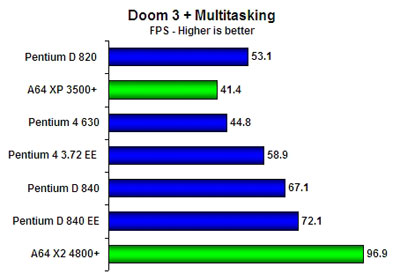
|
|
Advertisement:
All original content copyright James Rolfe.
All rights reserved. No reproduction allowed without written permission.
Interested in advertising on OCAU? Contact us for info.
|

|


